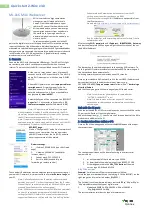
Migrating an 8.0 Directory Server to 8.1 on Another Machine
85
6.3.2. Migrating an 8.0 Directory Server to 8.1 on Another Machine
To upgrade Directory Server and move the instance from one machine to another, the 8.0 information
must be imported into the new instance manually. This is true for both moving to another machine and
moving to a new platform.
WARNING
Migration
cannot
change the hostname used by the Directory Server and Administration
Server. The old machine must have the same hostname as your new machine. To
commission a new machine on which to run Directory Server 8.1, first rename the old
machine (for example, change
ldap.example.com
to
ldap_old.example.com
),
then give the new machine the original name of the old machine (
ldap.example.com
).
Because the large number of configuration issues based on the Directory Server's
hostname — including the Console, replication, TLS/SSL, and Kerberos — it is extremely
difficult to rename the server. Red Hat strongly recommends that you do not attempt to
change the Directory Server hostname.
1. Back up all the Directory Server user and configuration data. For example:
cd /usr/lib/dirsrv/slapd-
instance_name
db2bak /var/lib/dirsrv/slapd-
instance_name
/bak/
instance_name
-2009_04_30_16_27_56
2. Export all of the database information to LDIF. The LDIF file must be named the name of the
database with
.ldif
appended. For example:
db2ldif -r -n userRoot -a /var/lib/dirsrv/slapd-
instance_name
/db/userRoot.ldif
db2ldif -r -n NetscapeRoot -a /var/lib/dirsrv/slapd-
instance_name
/db/NetscapeRoot.ldif
NOTE
Use the
-r
option if the server is used in replication.
3. On the new machine which will host Directory Server, install or upgrade the Directory Server 8.1
packages. For example:
yum install -y
This automatically updates the Red Hat Directory Server packages as well as any other required
packages.
Red Hat Directory Server 8.1 requires that all of the packages in the Red Hat Directory Server
channel be updated. Running simply
yum update
updates all Red Hat Directory Server and Red
Hat Enterprise Linux packages. To exclude packages from updating on your system, you can
use
--exclude
packages
, restrict the update to only the Red Hat Directory Server channel, or
explicitly list the packages to update. Run
man yum
for a list of options. For example:
yum install -y --disablerepo=* --enablerepo=rhel-x86_64-server-5-rhdirserv-8
















































